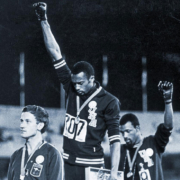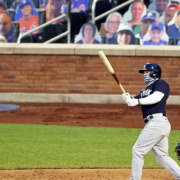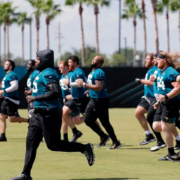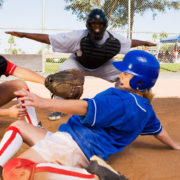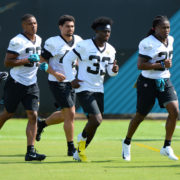The Athlete’s Voice
It was 1968 when I first was made aware of racial inequities in America. I was twelve years old. Growing up in Baltimore in an integrated environment, I had Black friends and Black teammates. I didn’t know they were different. I didn’t know anything about anything. I was twelve.
In my short lifetime I was aware that President John Kennedy had been assassinated. I knew Malcom X had been shot. And Dr. Martin Luther King, and Bobby Kennedy. They were political figures I didn’t know anything about except their names. That seemed to be just what happened.
My life was full of baseball fantasies, the Orioles and the Colts, school, my afternoon paper route and curb ball with my friends. When the Orioles had acquired Frank Robinson two years earlier from Cincinnati, I asked my Dad if he was Brooks’ brother. I verified that with my Dad this week because then, I was just a kid.
In October of ’68, my level of awareness took a giant leap forward. Tommie Smith and John Carlos had won the Gold and the Bronze in the 200 at the Olympics in Mexico. When they stood on the podium with no shoes and gloved-fists raised, I wanted to know what that was about. Smith and Carlos were two of my heroes. Both tall and fast, I wanted to be like them. They were sports icons to me and they had something to say. When they raised their fists in what Smith describes as “a cry for freedom,” my twelve-year-old mind weas jolted out of youthful innocence and into my first awareness of the real world. It essentially ended both of their athletic careers.
Do athletes have a voice? The answer is yes. Do you always have to agree with them? Of course not.
Perhaps 2020 is this generation’s version of 1968. An election year, protests in the streets and a spotlight on racial tensions.
When the Milwaukee Bucks decided to not play their scheduled playoff game in protest of a Black man being shot by a police officer in an altercation, it was a bold step taken by professional athletes not unlike Smith and Carlos’ action fifty-two years ago. Other teams and leagues followed suit, not just calling attention to the shooting but demanding change, now.
What kind of change? When the Jaguars postponed their practice for two hours on Thursday, they spent the time talking about “actionable” change that can happen right now.
Wide receiver Chris Conley has become a vocal leader for the Jaguars players efforts toward social justice. He described it this way:
“The thing that I really want people to get to a point of realizing that this is about life.’ This is about a life. And who are you to put a value on a life? Who am I to put a value on a life?” Conley said in a video conference with the media after Thursday’s practice. “And if we can—we need to get to that baseline of saying that a life matters. And that it has value beyond what his warrant was, beyond what his circumstances were, what he looked like, what was going on, whether he listened or not. And that’s the baseline that I want to get to people, that frustrates me more.”
While “actionable change” is an idea to talk about, the Baltimore Ravens went a step further, issuing a statement with specifics.
“This is bigger than sports,” their statement reads. “Racism is embedded in the fabric of our nation’s foundation and is a blemish on our country’s history. If we are to change course and make our world a better place, we must face this problem head-on and act now to enact positive change.
It is time to accept accountability and acknowledge the ramifications of slavery and racial injustice.”
Agree with that statement or not, the Ravens then outlined seven action points they want implemented immediately including arresting certain police officers involved in shootings as well as “encourage every citizen to act with respect and compliance when engaging with the police.”
Jaguars Head Coach Doug Marrone echoed the thoughts of much of his team.
“As a white guy, a white man in this country, I can’t even imagine what it’s like,” Marrone said on Thursday. “And I’ll never say I know what it’s like. But I do know this, the fire and intensity to make a difference, grows. I know we have a good understanding of what’s not acceptable in our country today. And I think that somewhere along the line we’ve got to figure that out, because obviously we want to do something that’s actionable, something that could create a change.”
“I can’t even explain or really put into words the emotion of the sadness, frustration, confusion,” he continued, adding he was fully committed to the process. “Where I beat myself up is like when you’re in a position of leadership or you have a voice within a team, you want to be able to show a path, show a way.”
One path to follow is what tennis star and Wimbledon finalist MaliVai Washington has done with his foundation. A Black man, Mal has, for nearly the past 25 years, gone directly into Black communities and schools here in town and effected real, “actionable” change. His foundation focuses on education and life skills. Calais Campbell, in his short three years here, did the same. He didn’t just write checks, he took real “actionable” steps in Black communities.
There’s no question athletes have a voice. And the question of “should they have a voice?” was answered by Jaguars wide receiver DJ Chark.
“I mean, I say, take away sports, at the end of the day, we’re all Americans,” he said this week when asked about someone saying athletes should stick to sports. “So, that’s like me telling someone who has a 9-5, whatever the job may be, to stick to that and not venture out and try to make your community better. If you’re not trying to make your community better, what are you doing? If you’re not trying to lead this world, lead this earth with making a positive impact, what are you here for? Whether it’s sports that gives you the platform, whether it’s music, entertainment, whatever it is. If you have a voice, I think if you’re contributing to something that is going to help, something that is positive, I think you should use it.”
A few years back I was inducted into the Bob Hayes Hall of Fame. I was thrilled at the honor, particularly because Tommie Smith was also a part of that year’s induction class. At the dinner that night, I happened to be seated right next to Smith.
“You changed my life,” I told him as we initially shook hands.
He turned his head and said, “How so?” with a quizzical look.
I explained the impact he had, from thousands of miles away, on a young kid from Baltimore.
Smith smiled and said, “Then it was good.” And we chatted all through the evening about our different and shared experiences in sports.
Telling that story to a Black NFL executive recently, he shook his head and noted, “Most of our guys, sadly, don’t know who Tommie Smith or John Carlos are.”
We might not know the names of all of the players across sports who are raising their voices and asking questions today. And we might agree or disagree with what they’re saying.
But there’s one thing we can all do:
Listen.

